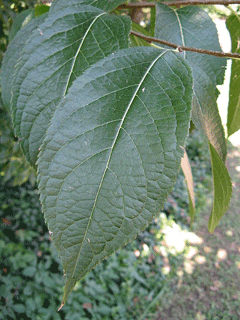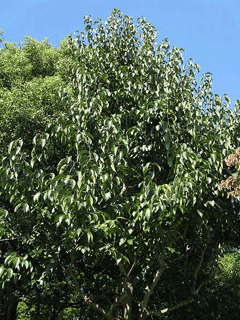 |
|
http://commons.wikimedia.org/wiki/User:KENPEI |
 |
| http://commons.wikimedia.org/wiki/User:KENPEI |
Translate this page:
Summary
Physical Characteristics

 Eucommia ulmoides is a deciduous Tree growing to 12 m (39ft) by 8 m (26ft) at a fast rate.
Eucommia ulmoides is a deciduous Tree growing to 12 m (39ft) by 8 m (26ft) at a fast rate.
See above for USDA hardiness. It is hardy to UK zone 5. It is in flower in April, and the seeds ripen from September to October. The species is dioecious (individual flowers are either male or female, but only one sex is to be found on any one plant so both male and female plants must be grown if seed is required). . The plant is not self-fertile.
Suitable for: light (sandy), medium (loamy) and heavy (clay) soils and prefers well-drained soil. Suitable pH: mildly acid, neutral and basic (mildly alkaline) soils. It cannot grow in the shade. It prefers moist soil.
UK Hardiness Map
US Hardiness Map
Synonyms
Plant Habitats
Woodland Garden Canopy; Sunny Edge; Dappled Shade;
Edible Uses
Edible Parts: Leaves
Edible Uses:
Young leaves[178]. No further details are given.
References More on Edible Uses
Medicinal Uses
Plants For A Future can not take any responsibility for any adverse effects from the use of plants. Always seek advice from a professional before using a plant medicinally.
Analgesic Anticholesterolemic Aphrodisiac Astringent Depurative Diuretic Hepatic Hypotensive
Sedative Tonic Vasodilator
Gutta-percha, known as Du Zhong in China, is commonly used in Chinese herbalism, where it is considered to be one of the 50 fundamental herbs[218]. It is considered to be an excellent tonic for the kidneys and liver, and is thought to act specifically on the lower part of the body[254]. Much interest has been aroused by Du Zhong's ability to reduce high blood pressure. In a clinical trial involving 119 people, 46% of those treated with the herb showed a significant reduction in blood pressure[254]. However, it seems to have little effect in cases of severe hypertension[254]. The stem bark is analgesic, anticholesterolemic, aphrodisiac, depurative, diuretic, hepatic, hypotensive, sedative, tonic and vasodilator[11, 46, 147, 176, 178, 218, 279]. Its use lowers blood pressure (the stir-fried bark is stronger than raw and a decoction is stronger than a tincture) and reduces the absorption of cholesterol[176]. It is used in the treatment of impotence, frequent urination, lumbago, weakness of the lower part of the body, aching back and knees, hypertension and threatened abortion[176, 254]. The flowers and the fruit are astringent[218].
References More on Medicinal Uses
The Bookshop: Edible Plant Books
Our Latest books on Perennial Plants For Food Forests and Permaculture Gardens in paperback or digital formats.

Edible Tropical Plants
Food Forest Plants for Hotter Conditions: 250+ Plants For Tropical Food Forests & Permaculture Gardens.
More

Edible Temperate Plants
Plants for Your Food Forest: 500 Plants for Temperate Food Forests & Permaculture Gardens.
More

More Books
PFAF have eight books available in paperback and digital formats. Browse the shop for more information.
Shop Now
Other Uses
Latex Wood
A rubber is obtained from the sap, but not in commercially viable quantities[11, 46, 61]. The leaves contain 3% dry weight of gutta-percha, a non-elastic rubber, used for insulation of electrical wires etc[74]. The gutta-percha is found in all parts of the tree and is extracted by alcohol[61, 174]. The wood is used for making Pattens (a type of shoe with raised soles)[178].
Special Uses
Carbon Farming
References More on Other Uses
Cultivation details
Industrial Crop: Hydrocarbon Management: Coppice
Succeeds in any well-drained moisture retentive soil in full sun with shelter from cold winds[200]. Prefers a good loamy soil[11]. A fast growing[1] and very cold-tolerant tree, withstanding temperatures down to about -20°c[74]. Trees are commonly cultivated in Russia and China, both for gutta percha and for the medicinal used of the stembark[11, 218]. By using different solvents it is possible to obtain both of these products and the residue is then used for energy production[218]. This species is the only hardy rubber tree that can be grown outdoors in Britain[11]. Dioecious. Male and female plants must be grown if seed is required.
Carbon Farming
-
Industrial Crop: Hydrocarbon
Materials, chemicals and energy include bioplastics, rubber, biomass products gasoline, jet fuel, diesel, butane, propane, biogas. Plants are usually resprouting plants and saps.
-
Management: Coppice
Cut to the ground repeatedly - resprouting vigorously. Non-destructive management systems maintaining the soil organic carbon.
References Carbon Farming Information and Carbon Sequestration Information
Temperature Converter
Type a value in the Celsius field to convert the value to Fahrenheit:
Fahrenheit:
The PFAF Bookshop
Plants For A Future have a number of books available in paperback and digital form. Book titles include Edible Plants, Edible Perennials, Edible Trees,Edible Shrubs, Woodland Gardening, and Temperate Food Forest Plants. Our new book is Food Forest Plants For Hotter Conditions (Tropical and Sub-Tropical).
Shop Now
Plant Propagation
Seed - best sown as soon as it is ripe in a cold frame. Stratify stored seed for 3 months at 2°c[113]. Germination is usually good and takes place in the first spring[K]. When they are large enough to handle, prick the seedlings out into individual pots and grow them on in the greenhouse for their first winter. Plant them out into their permanent positions in late spring or early summer, after the last expected frosts. Cuttings of half-ripe wood, July/August in a frame[11].
Other Names
If available other names are mentioned here
Native Range
TEMPERATE ASIA: China (Gansu Sheng, Guizhou Sheng, Henan Sheng, Hubei Sheng, Hunan Sheng, Shaanxi Sheng, Sichuan Sheng, Yunnan Sheng, Zhejiang Sheng)
Weed Potential
Right plant wrong place. We are currently updating this section.
Please note that a plant may be invasive in one area but may not in your area so it's worth checking.
Conservation Status
IUCN Red List of Threatened Plants Status :

Growth: S = slow M = medium F = fast. Soil: L = light (sandy) M = medium H = heavy (clay). pH: A = acid N = neutral B = basic (alkaline). Shade: F = full shade S = semi-shade N = no shade. Moisture: D = dry M = Moist We = wet Wa = water.
Now available:
Food Forest Plants for Mediterranean Conditions
350+ Perennial Plants For Mediterranean and Drier Food Forests and Permaculture Gardens.
[Paperback and eBook]
This is the third in Plants For A Future's series of plant guides for food forests tailored to
specific climate zones. Following volumes on temperate and tropical ecosystems, this book focuses
on species suited to Mediterranean conditions—regions with hot, dry summers and cool, wet winters,
often facing the added challenge of climate change.
Read More
Expert comment
Author
Oliv.
Botanical References
11174
Links / References
For a list of references used on this page please go here
Readers comment
| Add a comment |
|
If you have important information about this plant that may help other users please add a comment or link below. Only comments or links that are felt to be directly relevant to a plant will be included. If you think a comment/link or information contained on this page is inaccurate or misleading we would welcome your feedback at [email protected]. If you have questions about a plant please use the Forum on this website as we do not have the resources to answer questions ourselves.
* Please note: the comments by website users are not necessarily those held by PFAF and may give misleading or inaccurate information.
To leave a comment please Register or login here All comments need to be approved so will not appear immediately.
|
Subject : Eucommia ulmoides
|
|
|
|